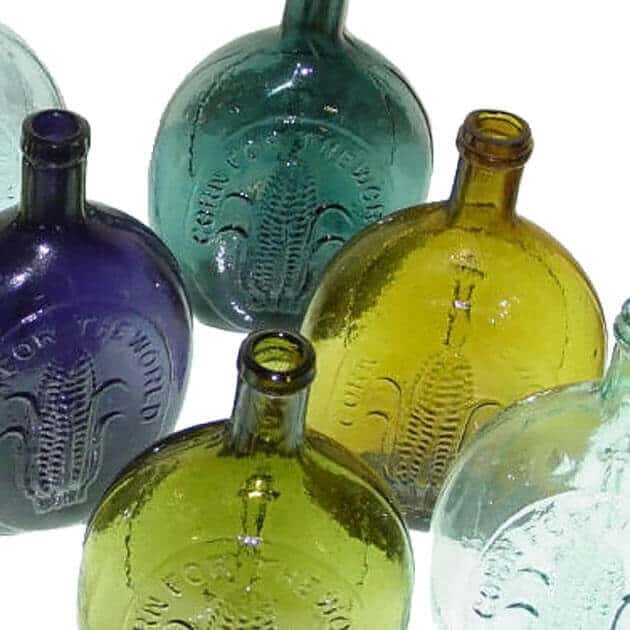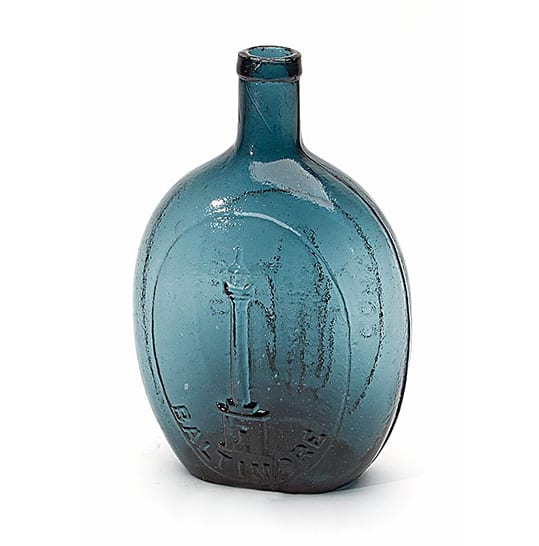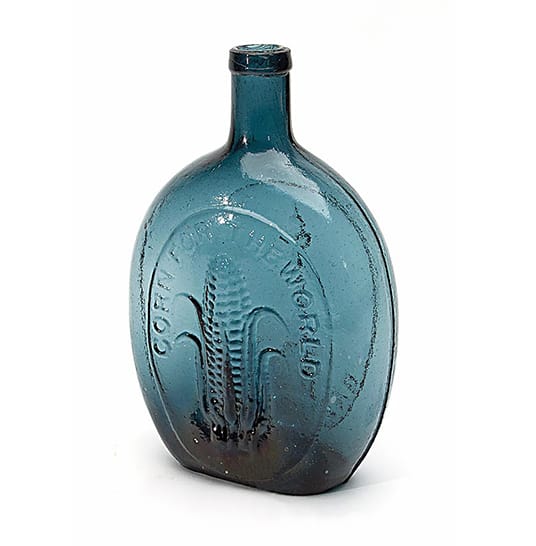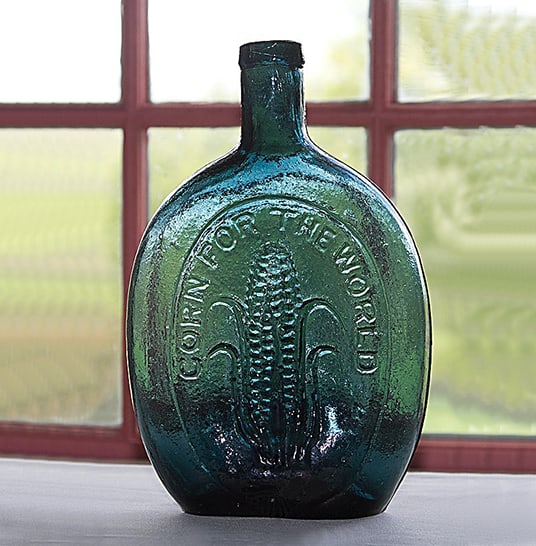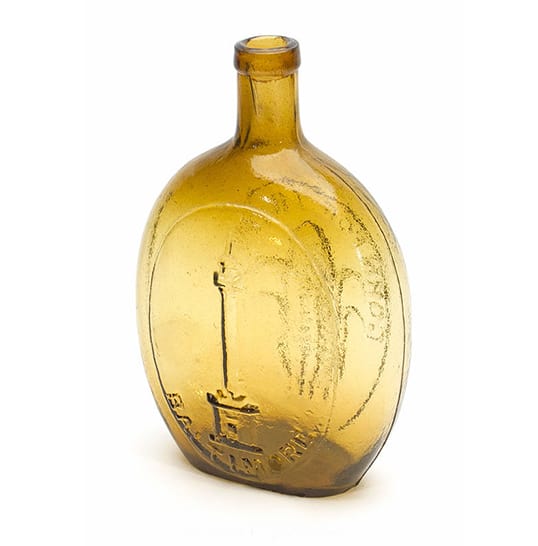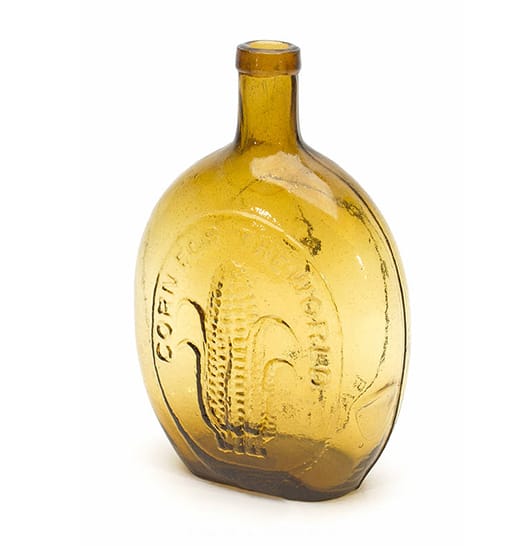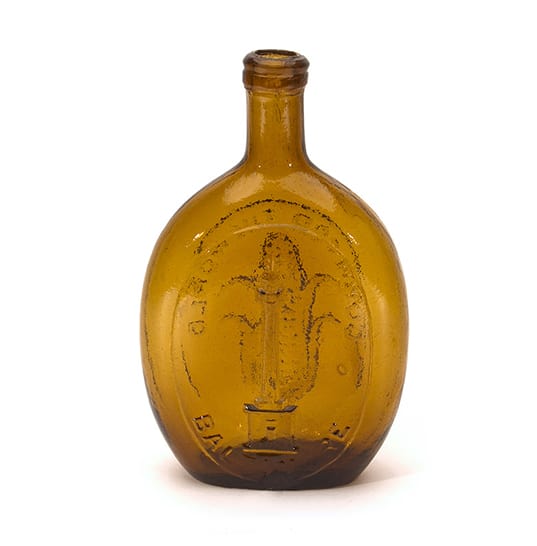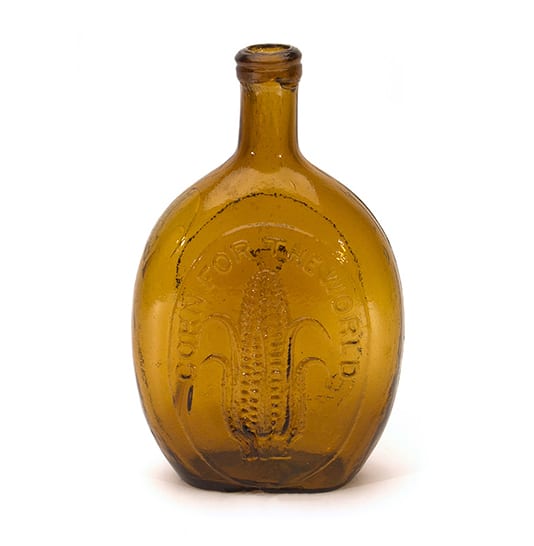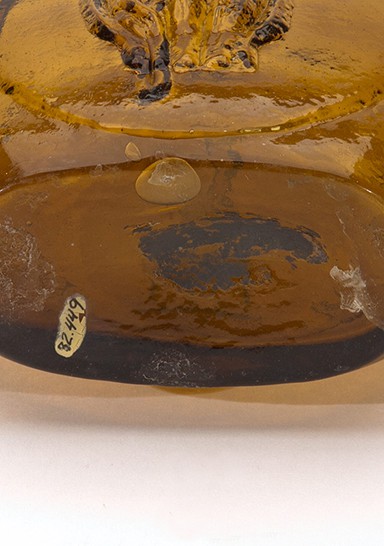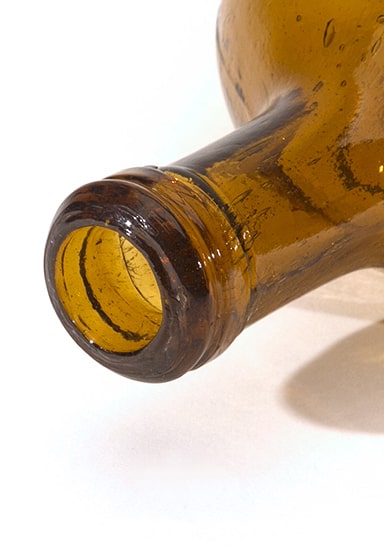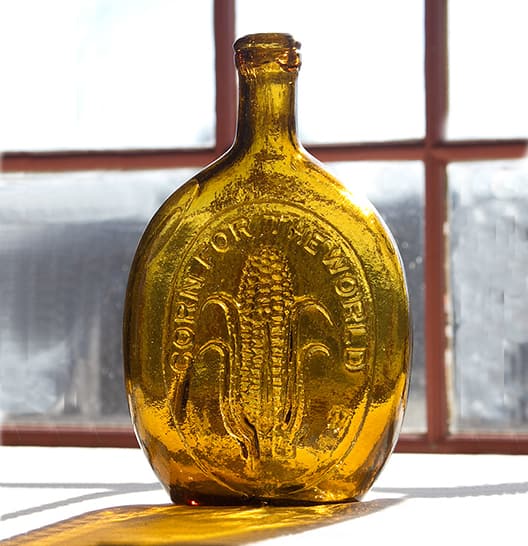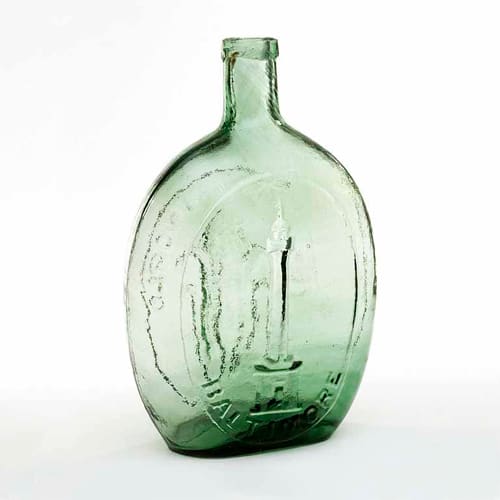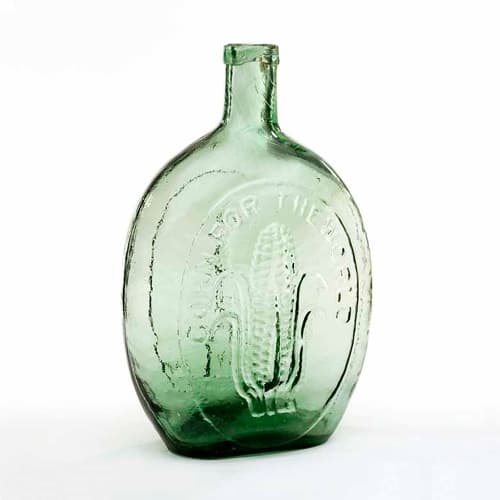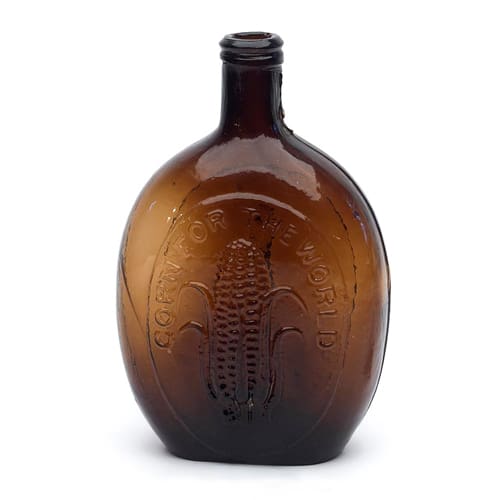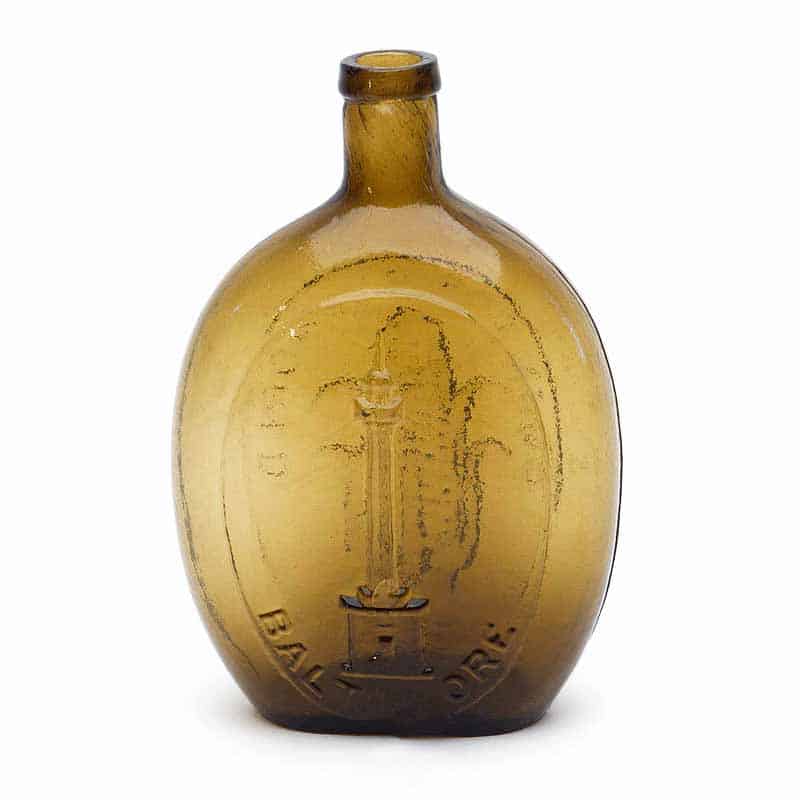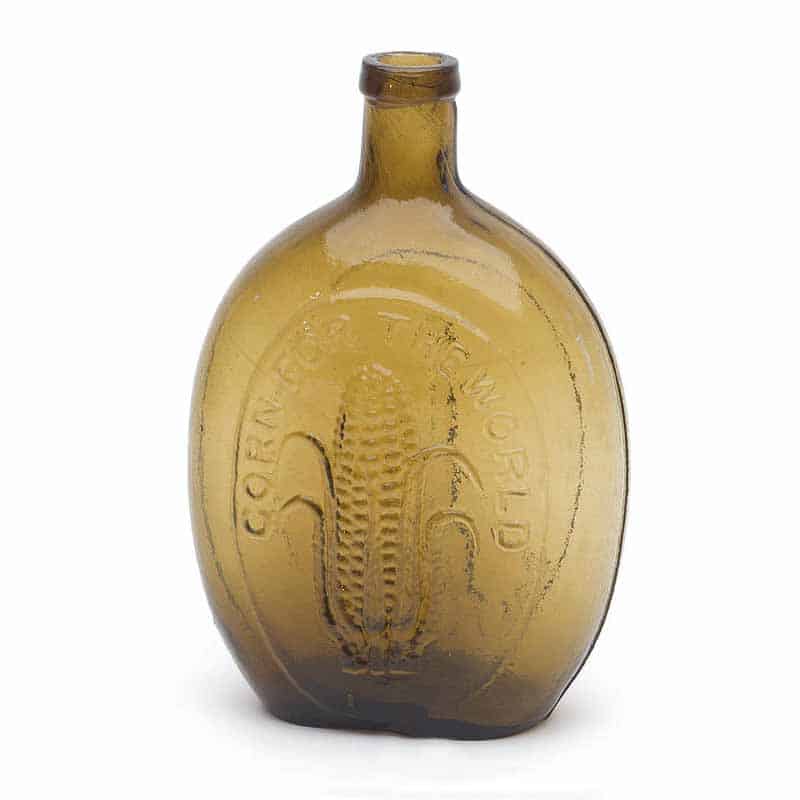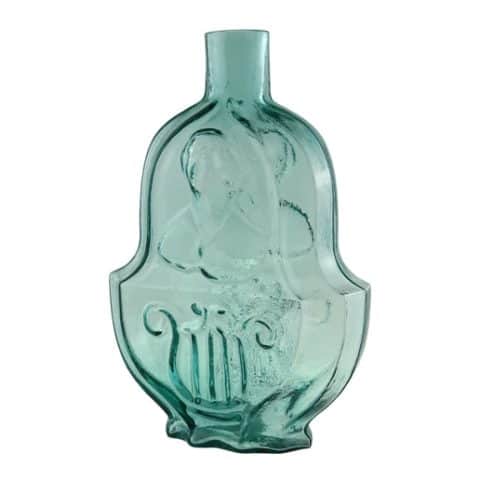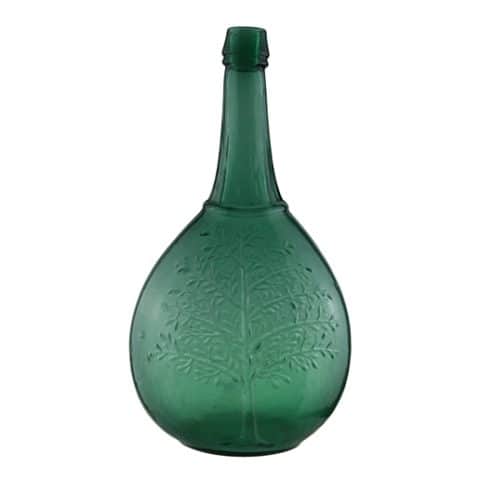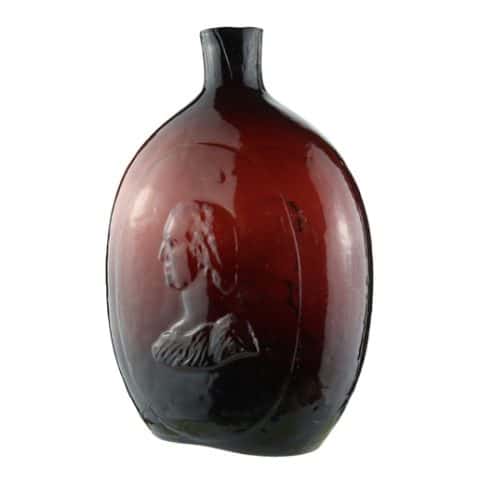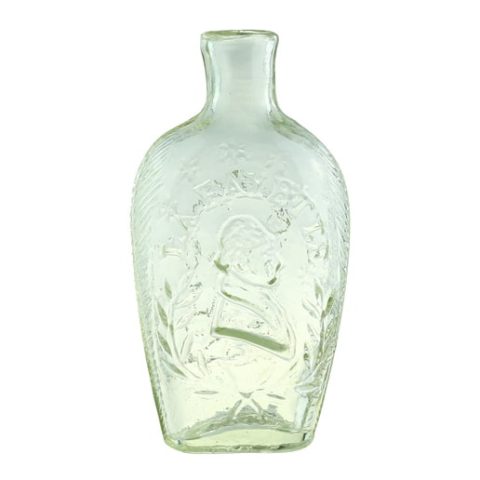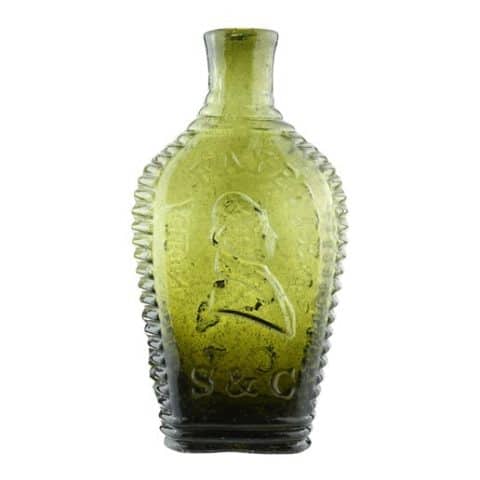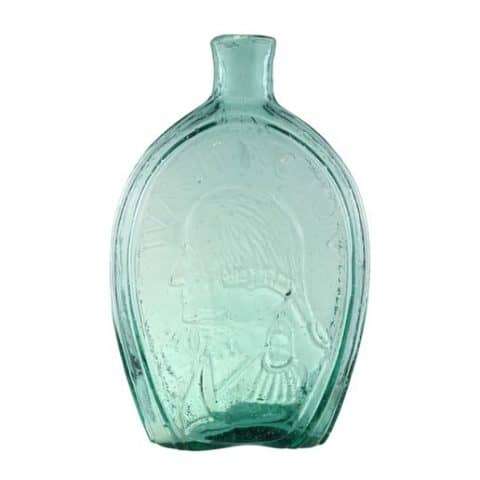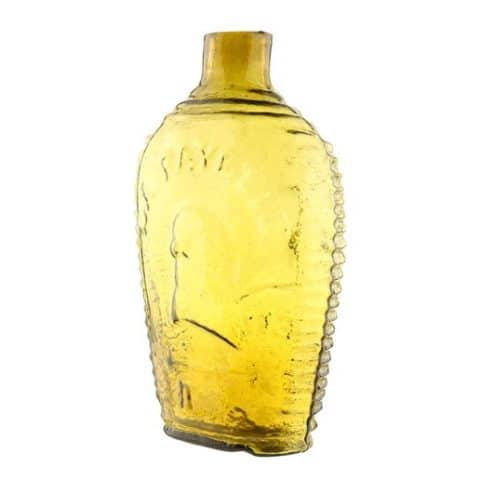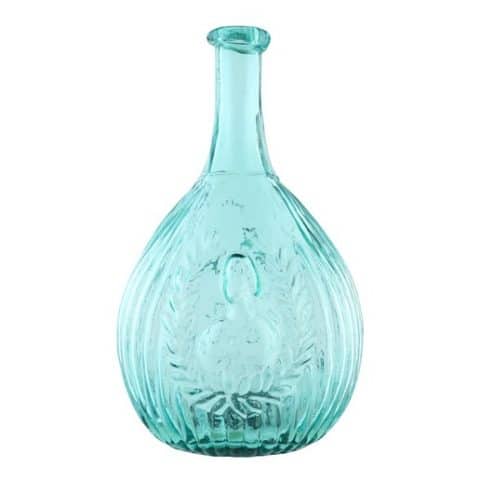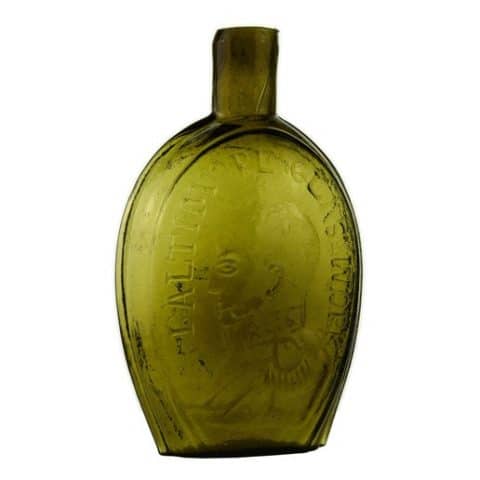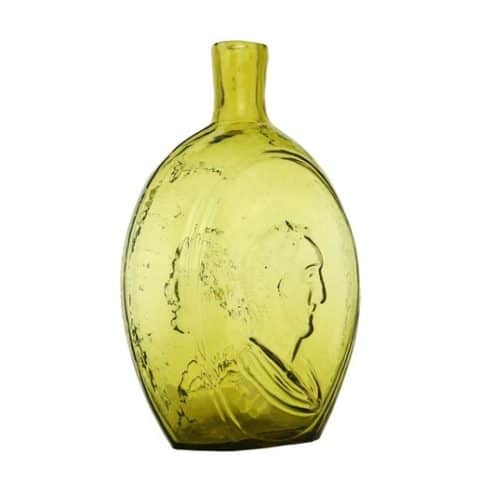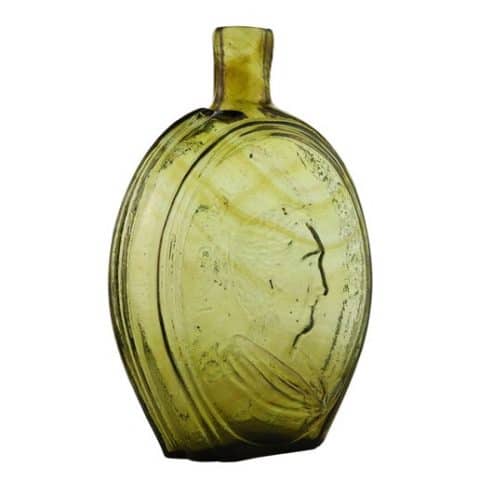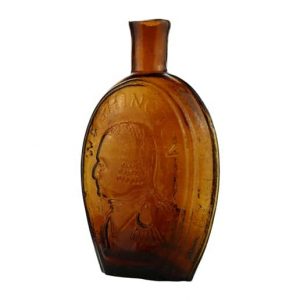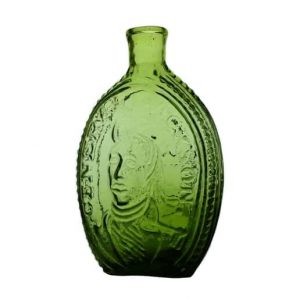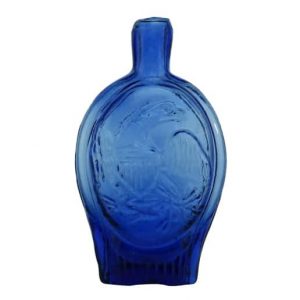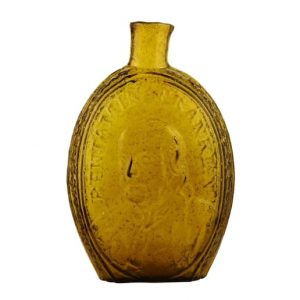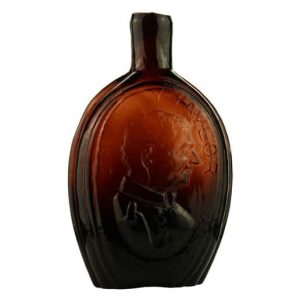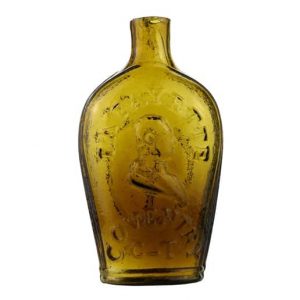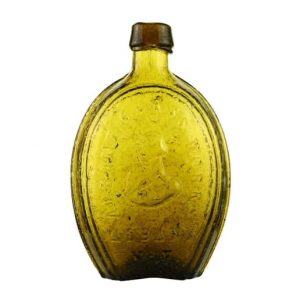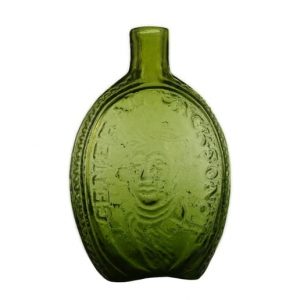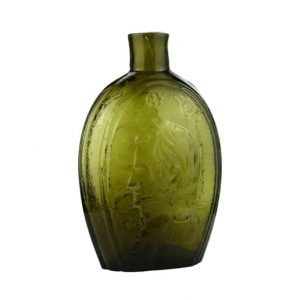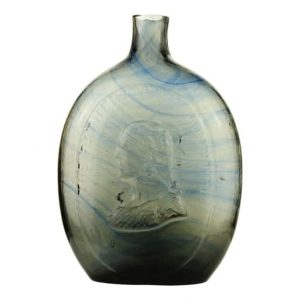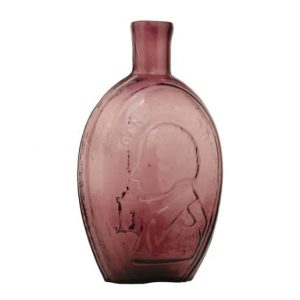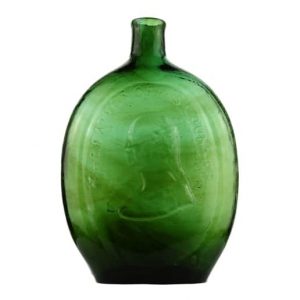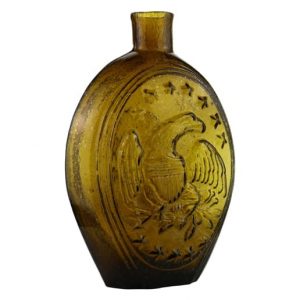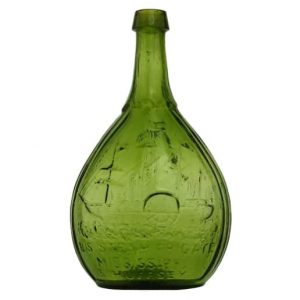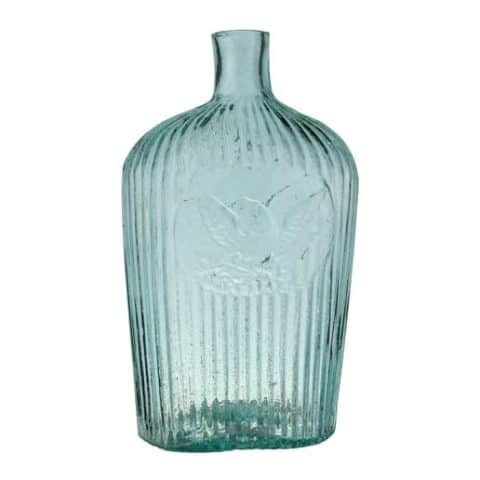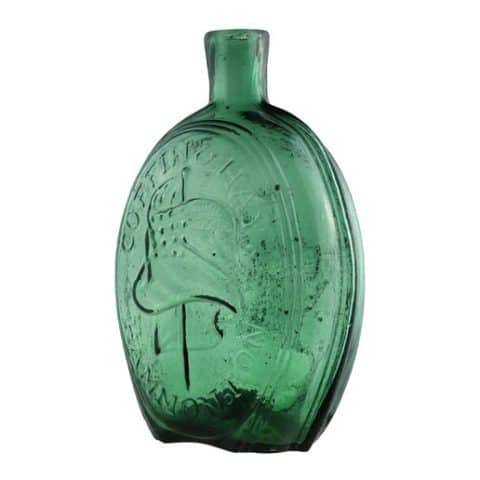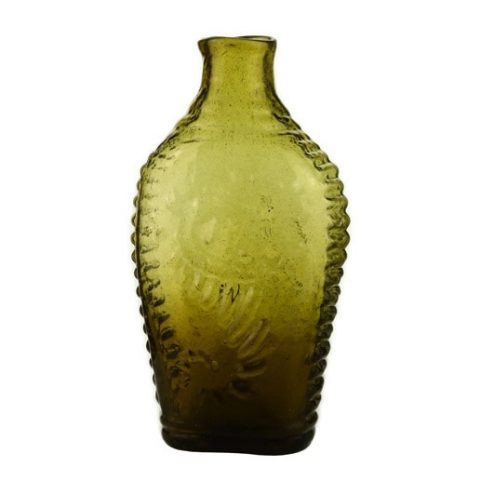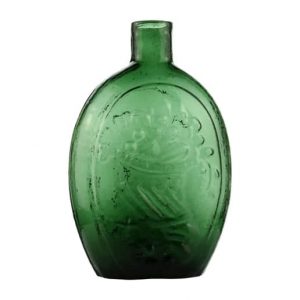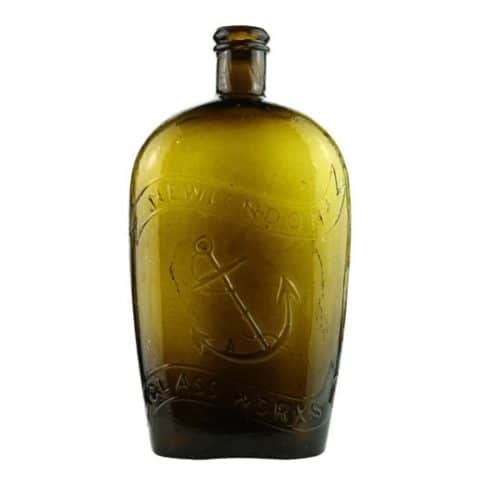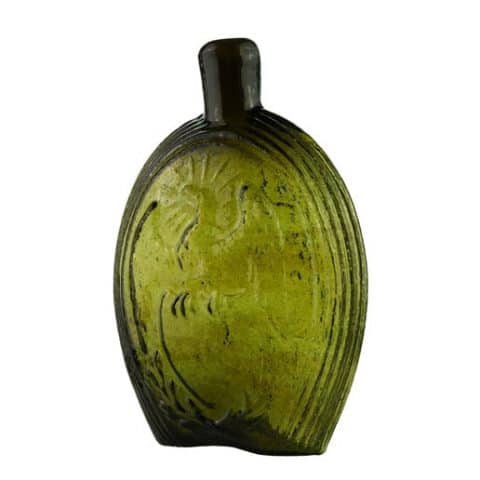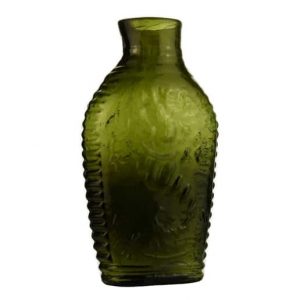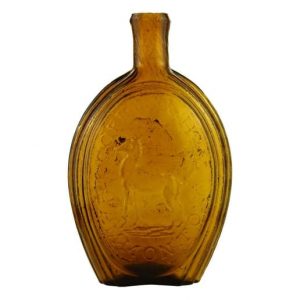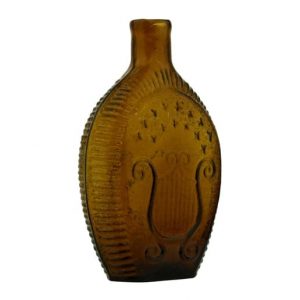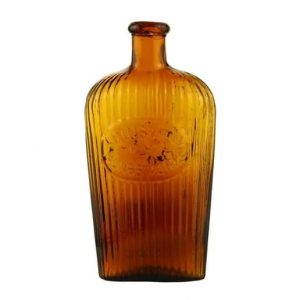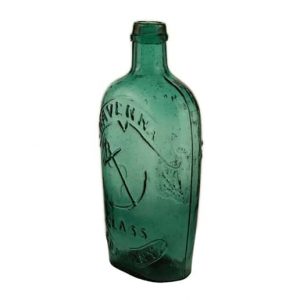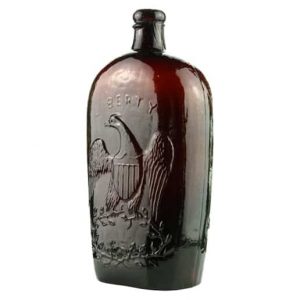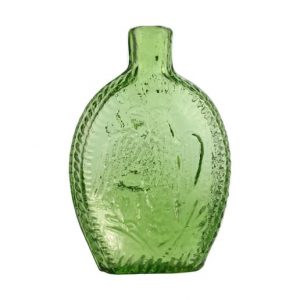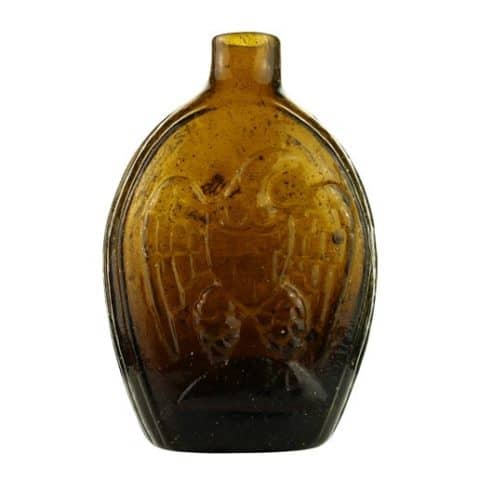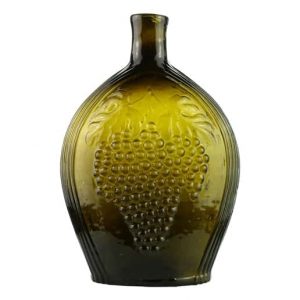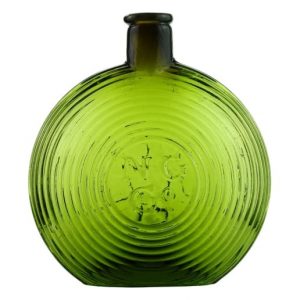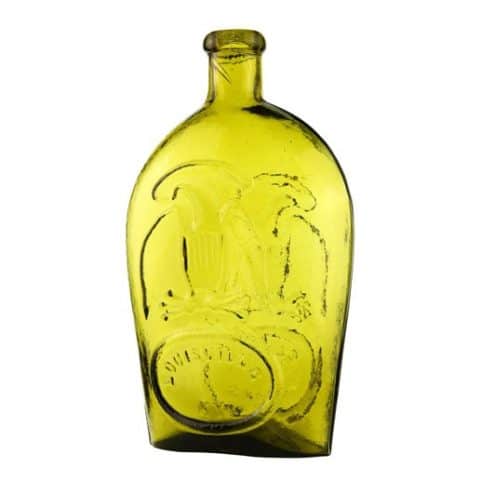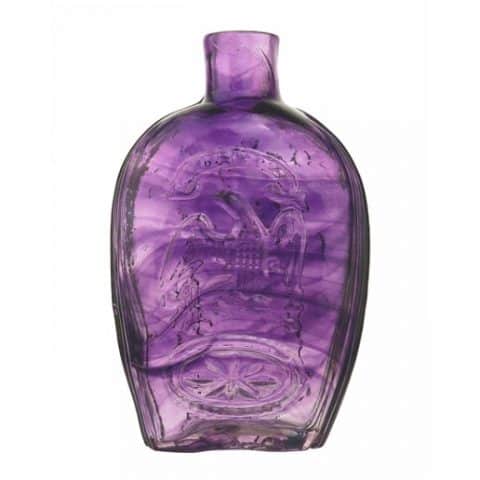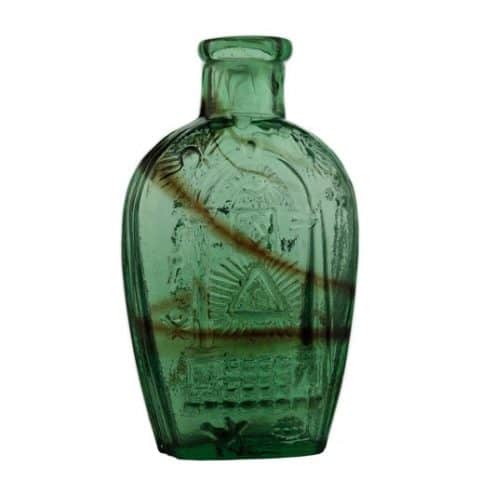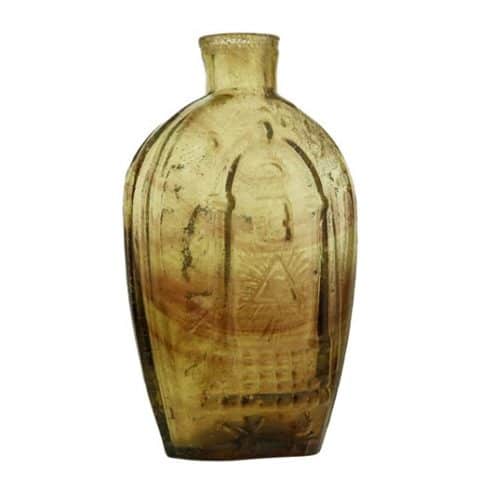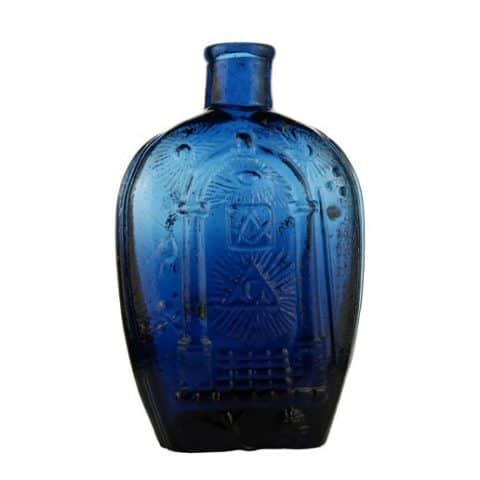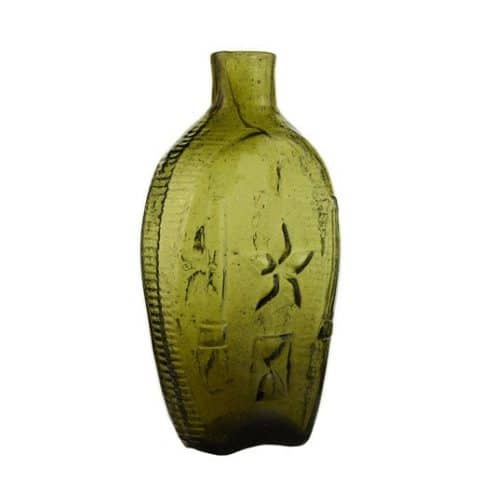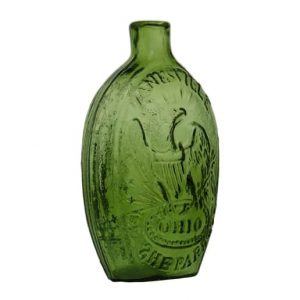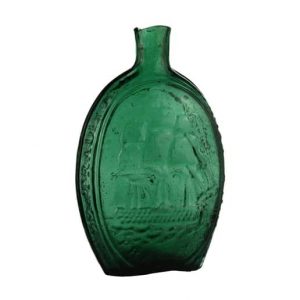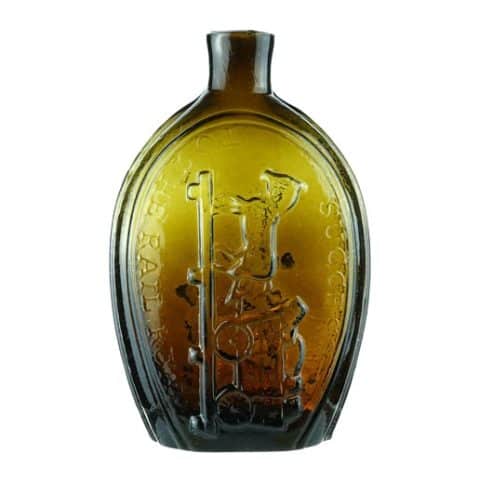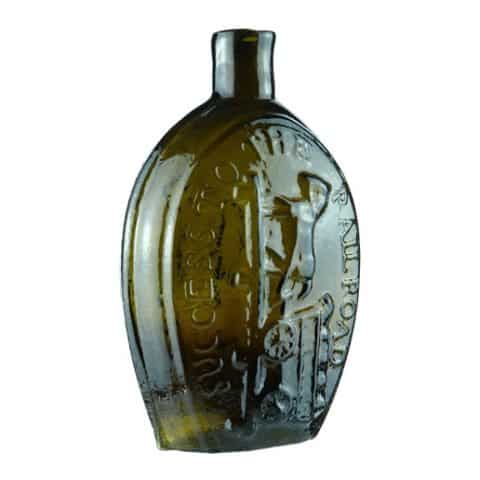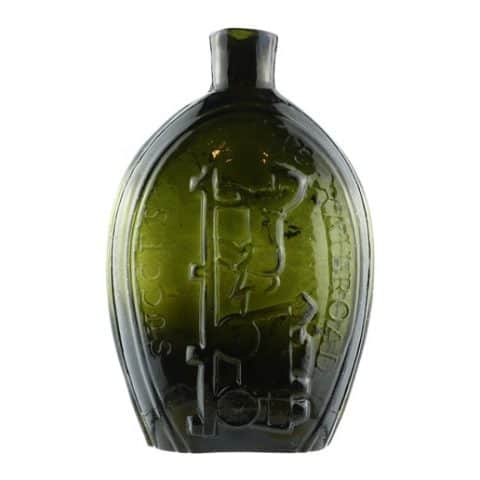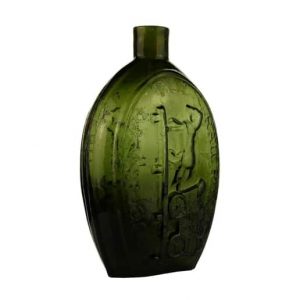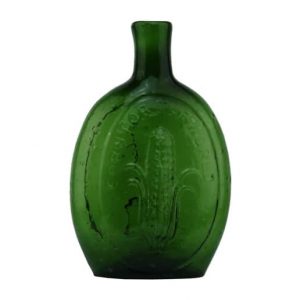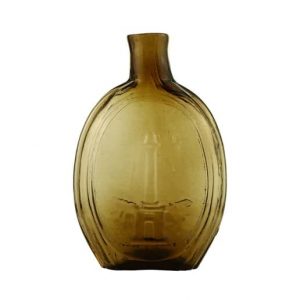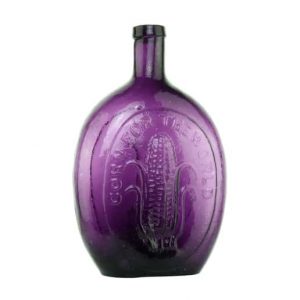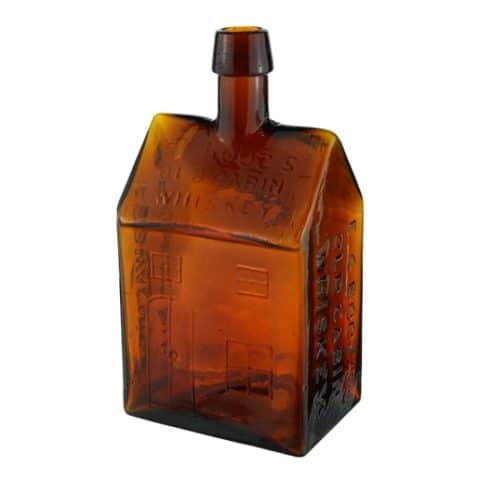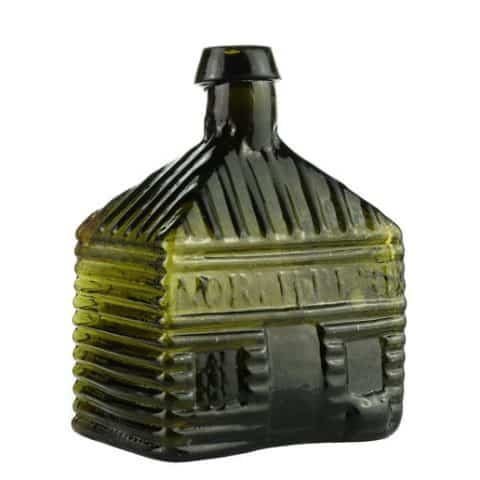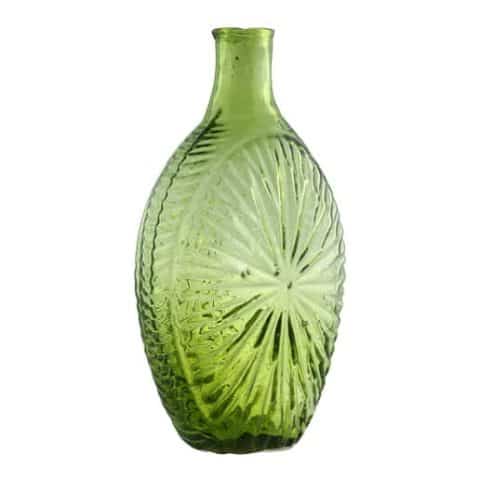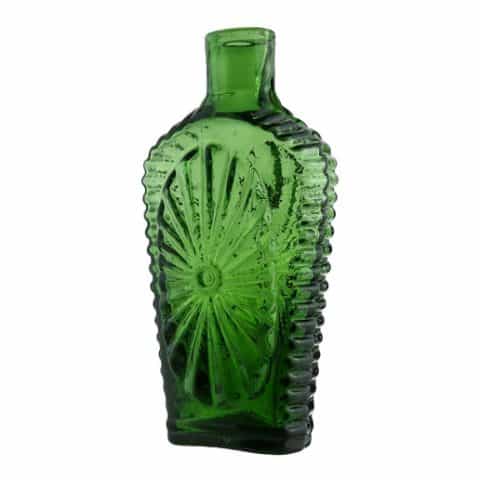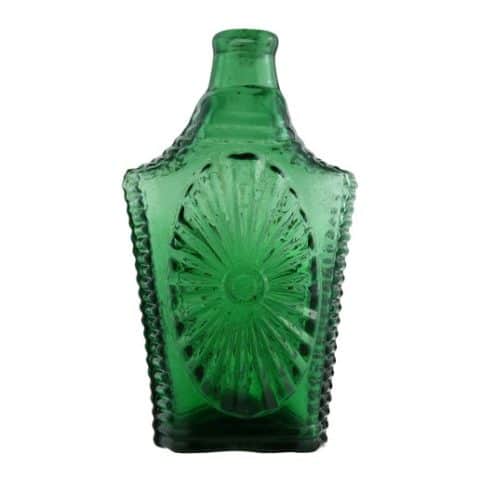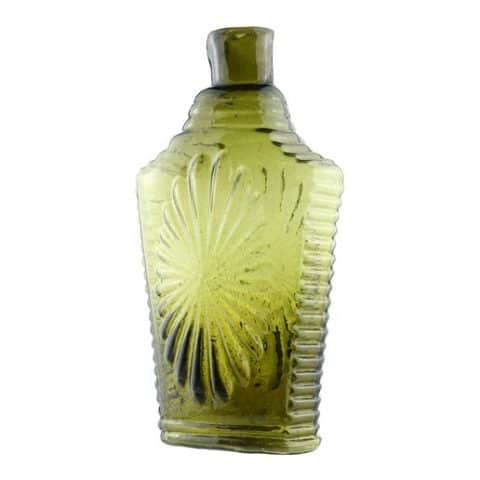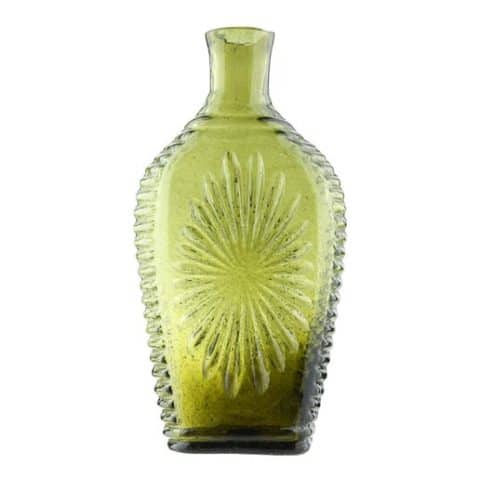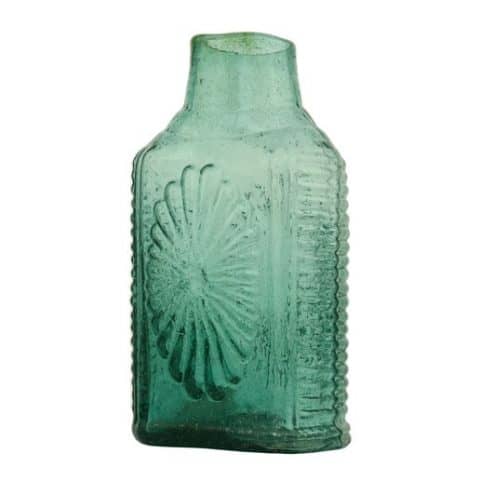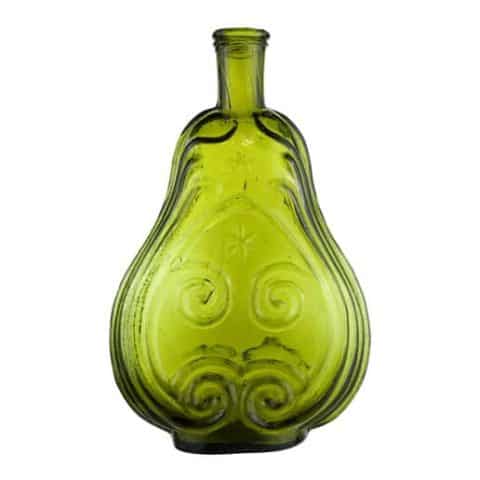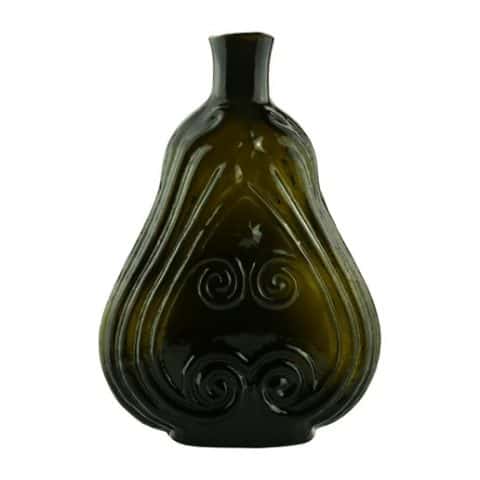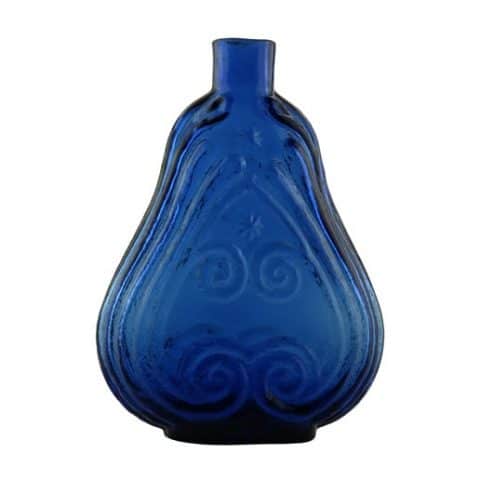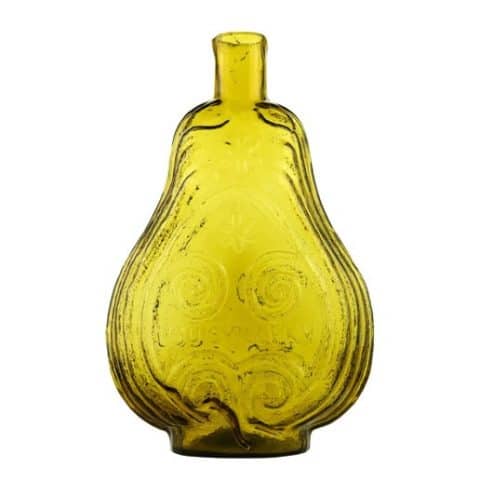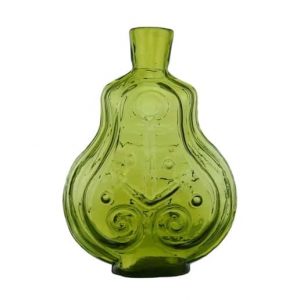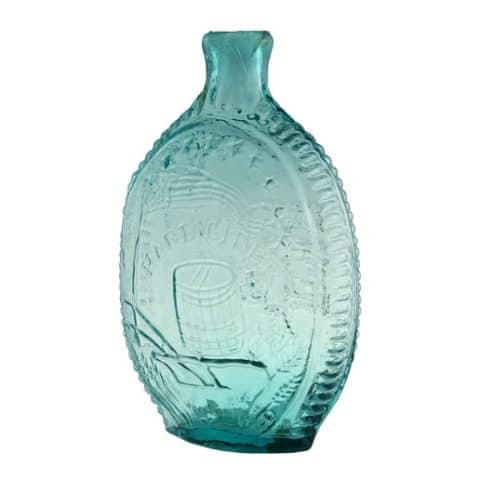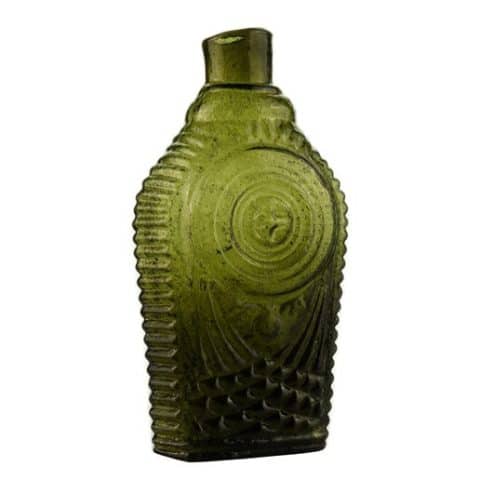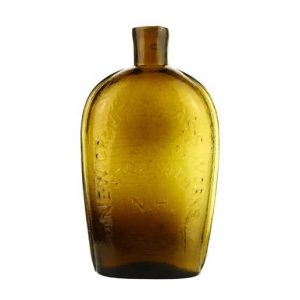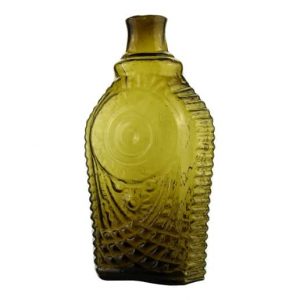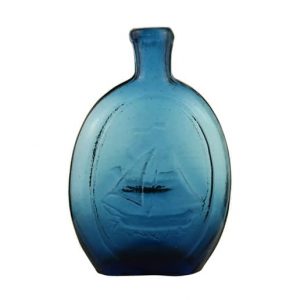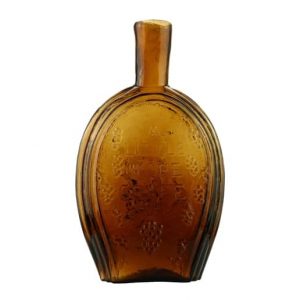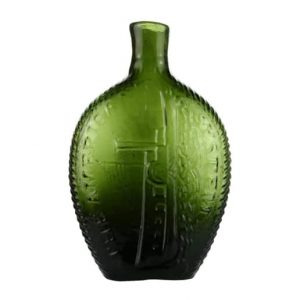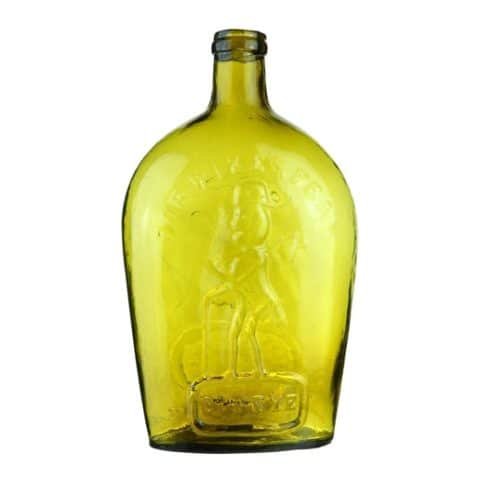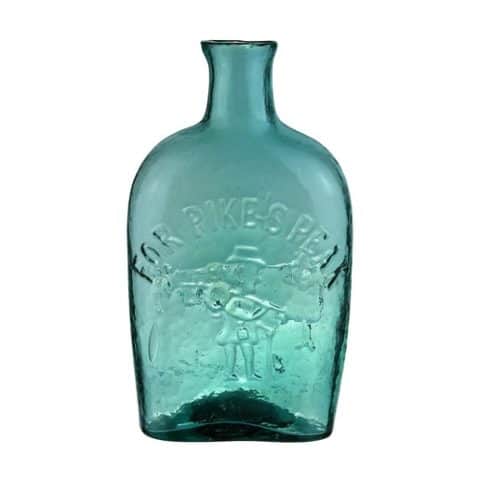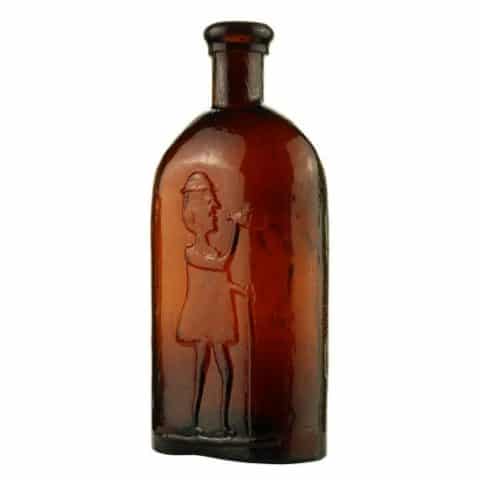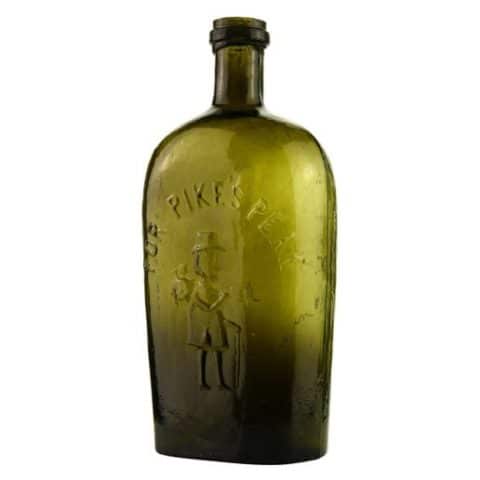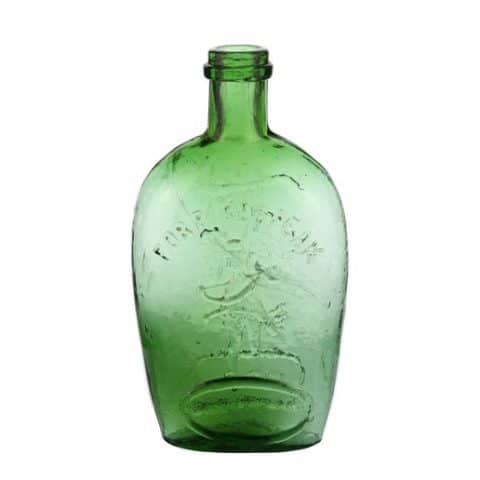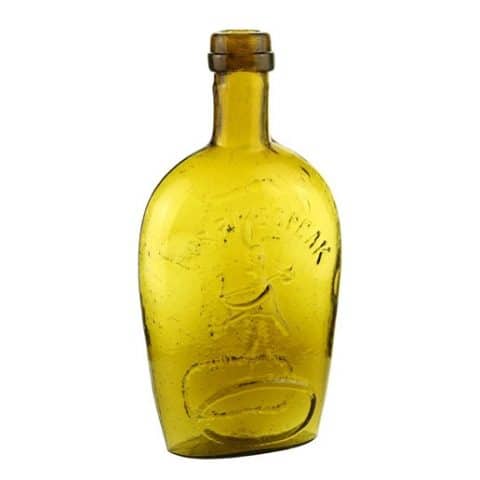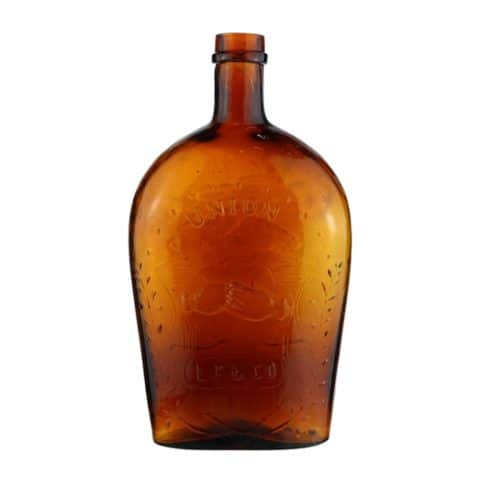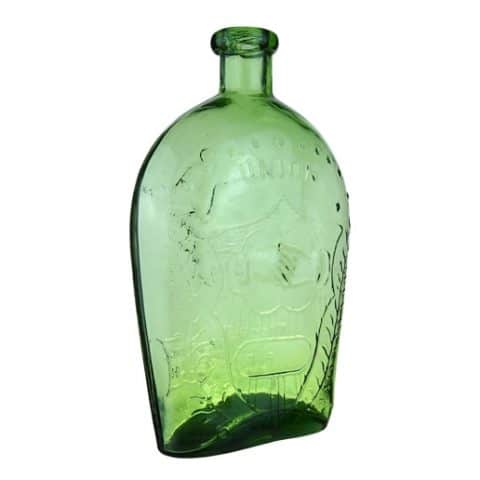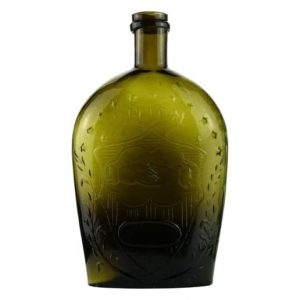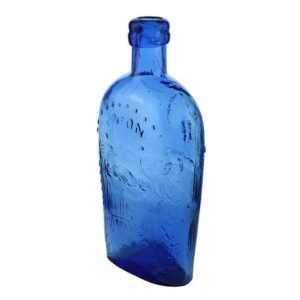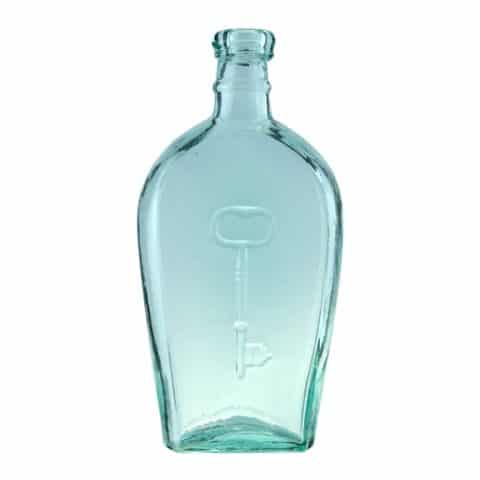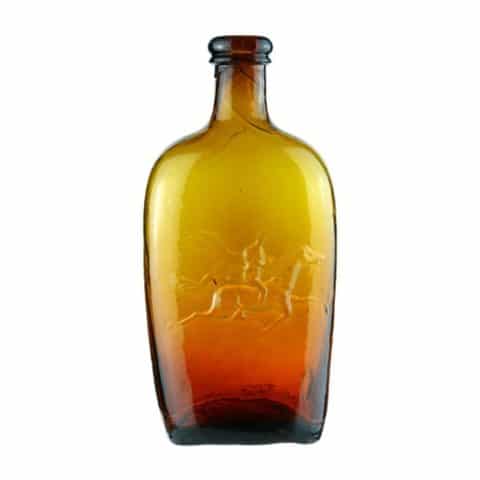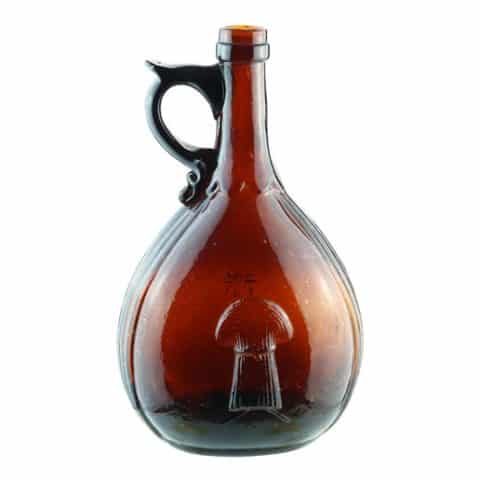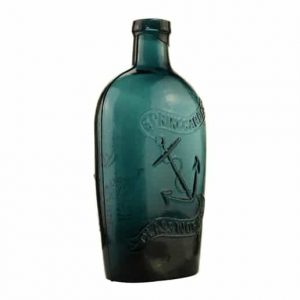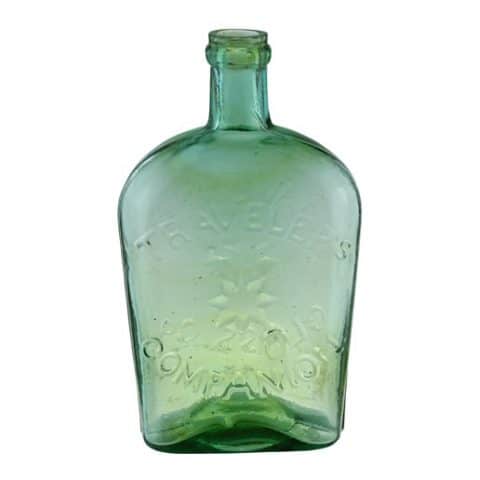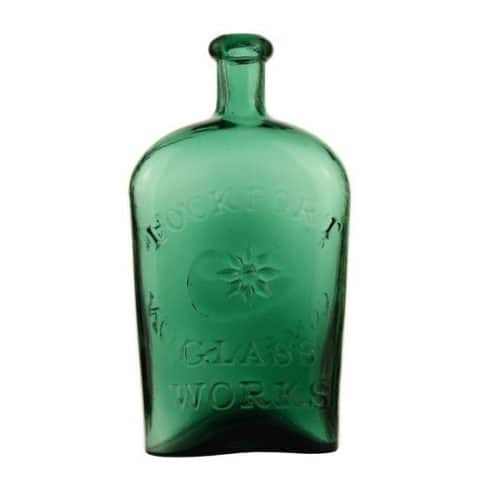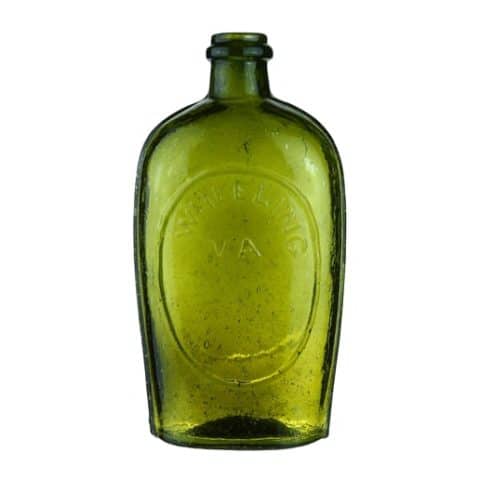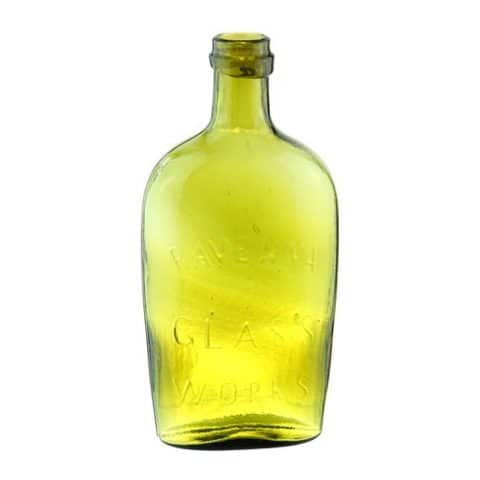GVI-4 “Baltimore” and Monument – Ear of Corn and “Corn For The World” Flask
GVI – 4
“Baltimore” And Monument – Ear Of Corn And “Corn For The World”
Historical Flask
Baltimore Glass Works, Baltimore, Maryland
Purple Quart
Provenance: Sandor P. Fuss Collection

The museum is pleased to have an example of an extremely rare color quart GVI-4 “Baltimore” and Monument – Ear of Corn “Corn for the World” historical flask to represent an outstanding mold cherished by collectors. The GVI-4 purple flask is extraordinary, though any flask in this mold, in any glass color, commands attention.
See the museum examples of Shriver’s Oyster Ketchup – Baltimore.
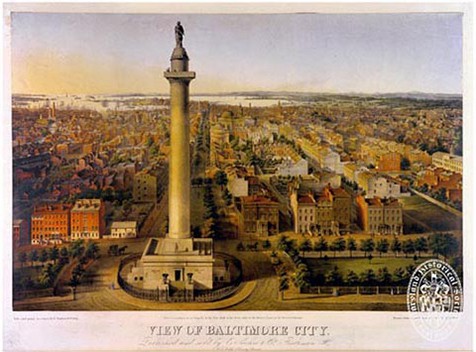
There are a number of charted historical flasks depicting the so-called “Baltimore Monument” such as the GI-20, GI-21, and GI-73 “Fells Point” portrait flasks, the GVI-2 “Fells Point” sloop flask and our subject GVI-4 “Baltimore” and Monument – Ear of Corn “Corn for the World” flask. There were also four other flasks with similar “monument-corn” motifs and embossed copy including the GVI-4a, GVI-5, GVI-6, and GVI-7, all illustrated below.
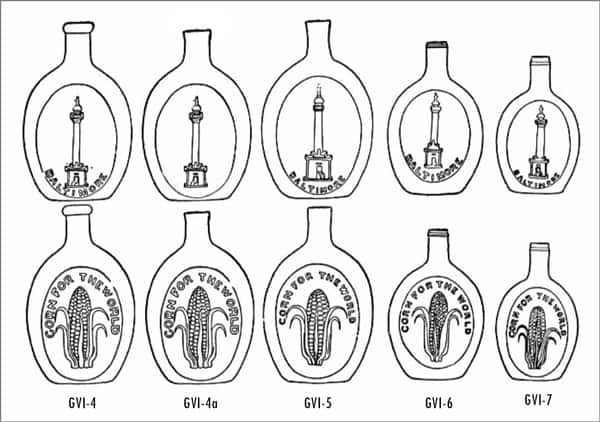
When looking at “Baltimore Monument” flasks, we need to understand that there are two different monuments that are depicted and embossed on the above-mentioned historical flasks.
The first is the “Battle Monument” which was built from 1815 to 1825 commemorating the War of 1812 and “To those brave citizens who fell on the 12th and 13th Sept. 1814 at North Point and Fort M’Henry.” The 39-foot tall monument was constructed in Battle Monument Square on North Calvert Street between East Fayette and East Lexington Streets and was designed by Baltimore architect J. Maximilian M. Godefroy. The crossed column wrappings make the monument distinctive in photographs and when embossed in glass.
See the museum example of GI-18 “Washington” And Bust – “Baltimore Glass Works” And Monument Portrait Flask.
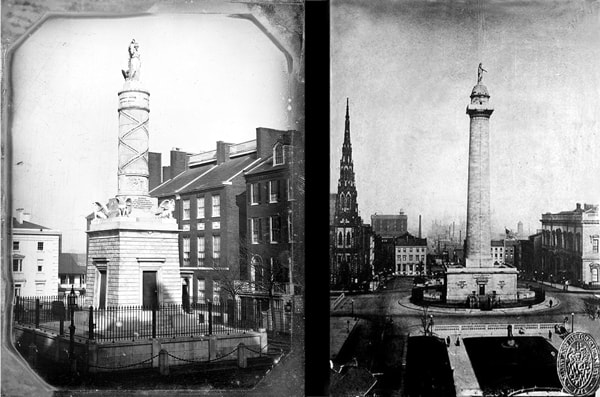
The second is Baltimore’s “Washington Monument” built to honor George Washington’s critical role during the Revolutionary War, Constitutional Convention, and his two terms as the first President of the United States which led to him eventually receiving the informal title, “Father of His Country.” The landmark is located at historic Mount Vernon Place, one of Baltimore City’s oldest neighborhoods, and originally home to the city’s wealthiest and most fashionable families. The monument was the first erected to commemorate George Washington in America and the name derives from the Mount Vernon home of George Washington.
On July 4, 1815, the cornerstone was laid for the 178 foot, 8-inch doric column monument designed by Robert Mills with the masonry work being completed by 1829. The 16-foot marble statue of George Washington was carved by the Italian sculptor Henrico Cancici. It was lifted with its pedestal into its present position with great ceremony on November 19, 1829, and widely publicized throughout newspapers in the United States.
The “Corn for the World” slogan that occurs with a partially husked ear of corn was a marketing boast for Baltimore’s harbor and commerce related to the export shipping of grain and corn.
See the museum example of a GI-74 Zachary Taylor – Corn For The World pint flask.
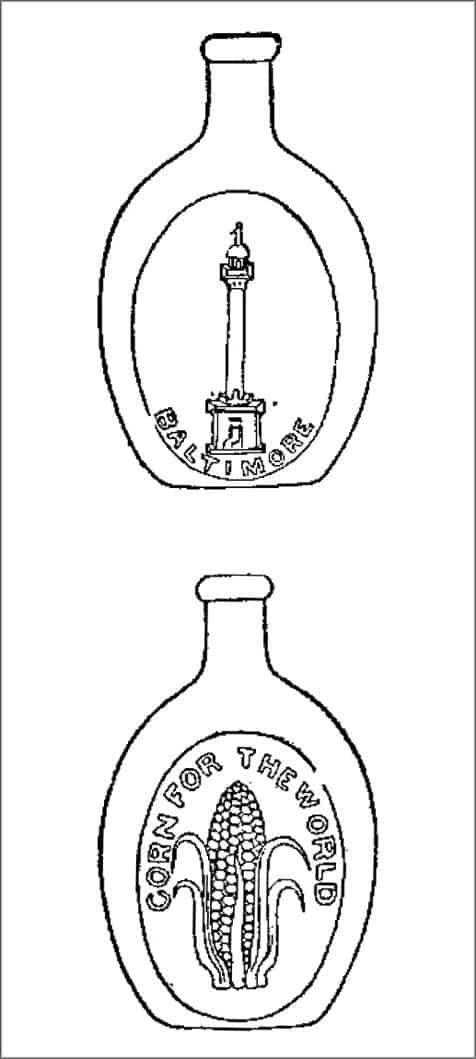
The obverse side of the flask features an embossed Washington Monument with embossed copy reading ‘BALTIMORE’ located under the monument in an arched manner. The monument and typography are surrounded by an oval frame. The step railing of the entrance door faces to the left.
The reverse side of the flask pictures an embossed ear of corn in high relief with four leaves curved away from the ear. The two leaves on the left are shorter and more confined compared to the right because of the embossed word ‘CORN’. The embossed copy reading ‘CORN FOR THE WORLD’ is placed in a semicircle above the ear of corn image. The ear of corn and typography are surrounded by an oval frame.
This quart flask is listed in McKearins as coming with four different lips which include a rounded collar, narrow flat collar, narrow beveled fillet, and round ring below a plain lip. The base and flask edges are smooth. There is no medial rib on the edge of the flask.
The GVI-4 quart flask can be found in many glass colors. Aqua is very common. Golden amber is considered common. Dark amber is comparatively scarce. Pale green, light green, yellow and red amber are considered scarce. Smoky brown, olive-yellow, yellow-olive, clear yellowish olive green, clear olive green, smoky clear, and pale blue are rare. Apricot, puce, cornflower, and light sapphire are very rare. Peacock blue, purple, and violet are considered extremely rare.
In Baltimore, glassmaking ranked as the third-largest industry in the 19th Century. An area of Federal Hill was once nicknamed “Glass House Row” or “Glass Hill” because of the glassworkers who lived there. The glass industry flourished since, at the time, glass, ceramics, and stoneware were the few materials that could be used for creating safe, watertight containers for liquids.
Baltimore Glass Works was established in 1780 and for many years was being run by William Baker & Sons and eventually the Baker Brothers Comany. This historical sketch below gives a good account of the glassworks.
CHARLES JOSEPH BAKER, merchant and manufacturer, Baltimore, Md., born in Friendsbury, the family home near Baltimore, May 28, 1821, died Sept. 23, 1894. It is related that his grandfather, William Baker, having been left an orphan by an Indian massacre near Reading, Pa., came to Baltimore at the age of twelve and lived to found and carry on the successful house of William Baker & Sons. This trade gave direction to the labors of his children.
In 1841, the subject of this memoir graduated from Dickinson College, Carlisle, Pa., where so many of the youth of Baltimore have gained an education and entered the office of the window glass factory of his father, then doing business under the name of The Baltimore Glass Works. In 1842, his brother, Henry J. Baker, and he started a paint, oil and glass business. The brothers were hard-working men, careful and shrewd, and met with marked success. As a branch of their business, they carried on the manufacture of glass for years in The Baltimore Window Glass, Bottle & Vial Works.
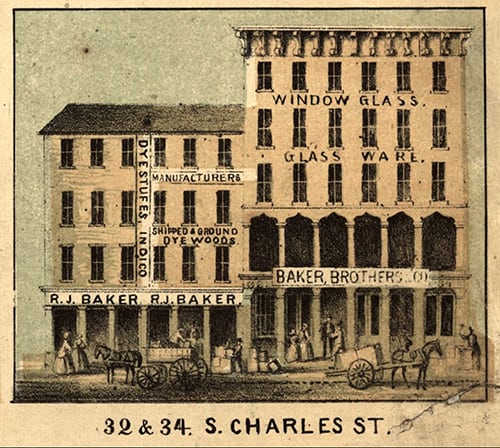
The firm changed its name to Baker & Bro., in 1848, and to Baker Bro’s & Co., in 1851. In 1865, Mr. Baker bought the interest of his partners, his sons taking their place. Mr. Baker was a very capable merchant. He imported chemicals, oil, and glue and knew how to increase his business by promoting auxiliary local industries.
He was connected with The Maryland White Lead Co., The Maryland Fertilizing & Manufacturing Co., The Chemical Co., of Canton, and other concerns. He was also interested in other enterprises merely as investments, including The Franklin Bank, of which he became a director in 1859 and in 1866 president; and The Canton Co., of which he was a director after 1860 and after 1870 the president, a position which he resigned in 1877. It was through his efforts that the Union railroad and tunnel were constructed; and, having bought control of The Baltimore Gazette, he was enabled to advance reform movements, which excited his lively interest. A man of probity, public spirit and great activity, Baltimore was the gainer by his labors.
Primary Image: GVI-4 “Baltimore” and Monument – Ear of Corn “Corn for the World” historical flask imaged on location by the FOHBC Virtual Museum midwest studio led by Alan DeMaison.
Support: Reference to American Bottles and Flasks and Their Ancestry by Helen McKearin and Kenneth M. Wilson, Crown Publishers Inc., New York, 1978.
Support: Reference to Corn for the World Historical Flasks at Peachridgeglass.com
Support: Reference to The Baker Brothers and the Baltimore Glass Works by Bill Lockhart, Beau Schriever, Bill Lindsey, and Carol Serr
Support: Reference to Charles Joseph Baker from America’s Successful Men of Affairs: The United States at large, Henry Hall, 1895.
Support Image: GVI-4 group photograph from the Tom Lines collection.
Support Images: Auction Lot 113: “Baltimore” And Monument – “Corn For The World” And Partially Husked Ear Of Corn Historical Flask, Baltimore Glass Works, Baltimore, Maryland, 1860-1870. Peacock blue, applied collared mouth – smooth base, quart. GVI-4 Here’s one that has it all; strong impression, great color, and fine condition. – Norman Heckler, Norman C. Heckler & Company, Auction #128
Support Images: Auction Lot 34: “Baltimore” And Monument – “Corn For The World” And Partially Husked Ear Of Corn Historical Flask, Baltimore Glass Works, Baltimore, Maryland, 1860-1870. Brilliant topaz yellow applied square collared mouth – smooth base, quart; (light exterior high point wear). GVI-4 Beautiful bright color and glass which is scattered with small bubbles. Fine condition. Robert and Janice Weekes collection. – Norman Heckler, Norman C. Heckler & Company, Auction #167
Support Images: Auction Lot 53: “Baltimore” And Monument – Ear Of Corn And “Corn For The World” Historical Flask, Baltimore Glass Works, Baltimore, Maryland, 1845-1860. Bright golden amber with an olive tone, applied double collared mouth – iron pontil mark, quart; (light exterior high point wear, shallow 1/16 inch flake from top of mouth). GVI-4 Brilliant color, little wear and strong mold impression make for one exceptional flask. Property of The Strong, sold to benefit the museum’s collections fund. – Norman Heckler, Norman C. Heckler & Company
Support Images: Auction Lot 13: “Baltimore” And Monument – “Corn For The World” And Partially Shucked Ear Of Corn Historical Flask, Baltimore Glass Works, Baltimore, Maryland, 1860-1870. Brilliant yellow amber with an olive tone, applied short sloping collared mouth – smooth base, quart. GVI-4 Beautiful color, fine condition, strong embossing. Warren “Bud” Lane collection. – Norman Heckler, Norman C. Heckler & Company
Support Images: Auction Lot 21: “Baltimore” And Monument – “Corn For The World” And Partially Shucked Ear Of Corn Historical Flask, Baltimore Glass Works, Baltimore, Maryland, 1860-1870. Apricot puce, applied double collared mouth – smooth base, quart; (minor blemishes to include shallow bubble bursts and some exterior high point wear). GVI-4 Gorgeous brilliant color, fine condition, strongly embossed. Warren “Bud” Lane collection. – Norman Heckler, Norman C. Heckler & Company
Join the FOHBC: The Virtual Museum is a project of the Federation of Historical Bottle Collectors (FOHBC). To become a member.

